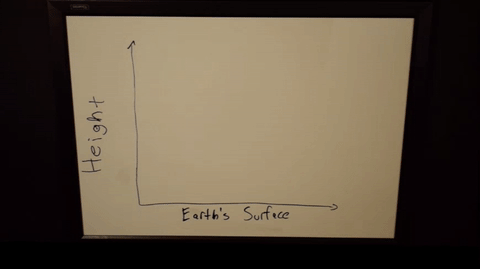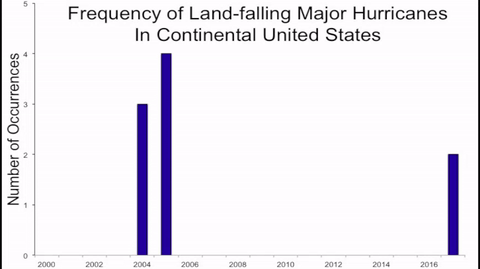Dissecting An Active 2017 Hurricane Season
November 30th marked the end of Hurricane Season but this past August and September were extremely active periods for tropical weather in the Atlantic Basin. With Harvey, Irma, and Maria all impacting the United States, it may have seemed like the tropics were more active than ever. Why was it such an active period and have we seen this before? Okay, let’s science!
For the whole story, watch the video above or read the post below (or both!). To see more of these videos, click here to subscribe.
You’ve probably noticed that hurricanes are in the news more often in the late summer as compared to the middle of winter. That’s because hurricane season starts on June 1st, peaks in mid-September, and ends on November 30th. Tropical systems can occur any time of the year but the vast majority occur during hurricane season. This is mainly because tropical cyclone formation only occurs when ocean waters are around 80 degrees Fahrenheit or warmer. It can’t just be one small patch of ocean either, warm ocean waters must exist over a fairly large area and be about 150 feet deep. Warm water acts as a fuel, providing tropical systems with heat and moisture they need to thrive.
But it takes more than just warm water. Hurricanes also need a conducive atmosphere. As water evaporates from the ocean surface into a tropical system, it needs to enter an atmosphere that’s favorable for moist convection. Moist convection is when air rises and condenses into clouds and precipitation. A necessity for any rain shower or thunderstorm. The three ingredients for moist convection: 1) lift or air moving vertically; 2) an unstable atmosphere; and finally 3) ample moisture.
So, to start you need air moving upward. For tropical systems, this is provided by a pre-existing atmospheric disturbance, commonly a storm system entering the Atlantic Ocean off the African Coast. Once these systems provide surface lift, we’re at the next ingredient where the air must enter an unstable atmosphere. This exists when air initially rises and then continues to rise without anything actively forcing it upward. The opposite of this is a stable atmosphere where air returns to its original position after rising. The third and final ingredient to moist convection is, well... moisture! A moist atmosphere allows for rising air to cool and condense forming clouds and precipitation.

Now we have an extensive area of convection, with clouds, rain, and storms. The final piece to maintaining and strengthening this convection is low levels of vertical wind shear in the air surrounding the system. Vertical wind shear is the magnitude of how wind changes with speed and direction, up and down in the atmosphere. For example, an atmosphere with absolutely no vertical wind shear has the same wind speed and wind direction just above the surface, fifty feet above the surface, five hundred feet above the surface, and all the way up. An atmosphere with a lot of vertical wind shear interferes with the structure of a tropical cyclone and commonly causes it to weaken. As it turns out, vertical wind shear is, on average, relatively low in September. Another reason why it’s the peak of hurricane season.

Why am I telling you all of this? Because from August to September, all of these ingredients were in place to create a chaotic period of tropical activity.
During every hurricane season, waters are warm enough for tropical cyclone formation but sometimes the other ingredients aren’t there. There may not be enough storm systems exiting the African coast to provide lift or there’s a lot of shear that inhibits tropical cyclone formation. Just like a good cake, it takes the perfect amount of heat, moisture, and ingredients to bake up good structure.
To get an idea of how tropical activity varies year to year, let’s look at Atlantic tropical cyclone frequency since 2000.

As you’ll see, tropical activity varies year-to-year, being as active as 2005 with twenty-eight tropical storms, fifteen hurricanes, and seven major hurricanes. Or it can be as inactive as 2009 with nine tropical storms, three hurricanes, and two major hurricanes. There have been seventeen tropical storms, ten hurricanes, and six major hurricanes in the 2017 Atlantic hurricane season. Three of the six major hurricanes this season have made landfall on United States coastline. This is kind of a big deal.
To put this into context, let’s look back on the year-to-year and focus on just major hurricanes that have made landfall in the continental united states. You’ll notice a gap. From 2006 to 2016, eleven years, there were zero landfalling major hurricanes. And now, in 2017, there have been two. Side note: this doesn’t include Maria because its landfall was on U.S. coastline but not in the Continental U.S.

So what’s with the gap? Major hurricanes were around but they just didn’t hit U.S. coastline. Hurricanes are steered by large air masses and it just turns out for eleven years, no major hurricanes were steered into the United States. Interestingly, in 2016, Hurricane Matthew almost broke the streak but was downgraded to a category 2 hurricane (not considered major) before making landfall.
Finally, let’s quickly talk about global warming. The current scientific consensus is that tropical storms and hurricane frequency will probably not increase as global temperatures rise. There is, however, some disagreement on this topic and the current consensus is not very certain. It’s safe to say, though, that this would have been an active tropical season in a climate unaffected by humans. A warming atmosphere and ocean do have implications for other aspects of hurricanes including intensity, rainfall rates, and storm surge impacts but that warrants an entire post in itself.
To sum it up, the high level of tropical activity we’re seeing is not unprecedented. It has been a really, really active August & September with many of these storms impacting land. But when the Atlantic is warm and the atmosphere above the Atlantic is primed for tropical development, this type of activity can be expected. So while it may seem like the tropics are more active than they’ve ever been, it’s just an active year during the peak of hurricane season. Thanks for listening!




